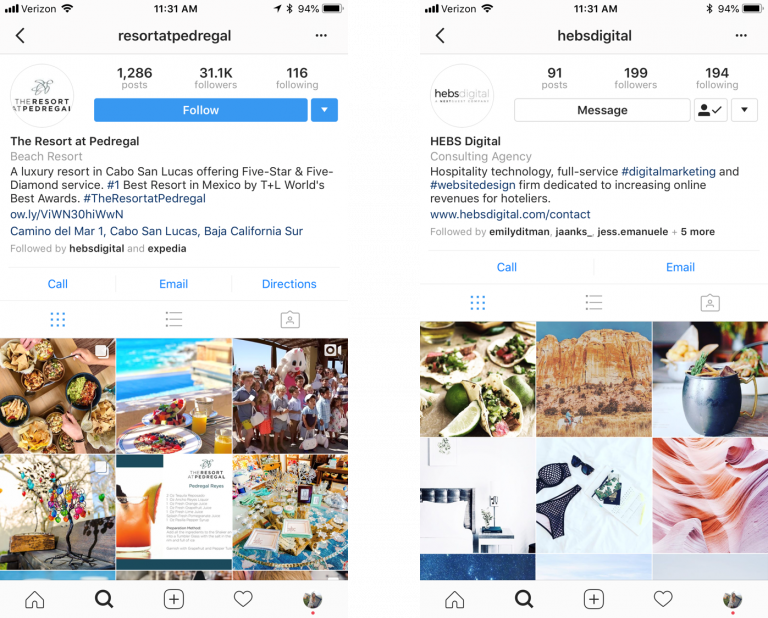
By Margaret Mastrogiacomo, Vice President Strategy
This month, the latest digital innovations include new publishing features on Google My Business listings, the new Google Outstream Video Ad format, and new Instagram profile bio features. The industry is also abuzz with the fast-approaching launch of the GDPR. From SEO to design, read on to learn the top five things you need to know now in hotel digital marketing, and stay informed.
1. SEO: Google My Business now allows you to publish updates visible in search and Google maps.
Google recently added the ability to create posts and updates on Google My Business listings. Posting through Google My Business lets you publish your events, products, and services directly to Google Search and Maps. By creating posts, you can place your timely content in front of customers when they find your business listing on Google. While this new feature is currently not available for hotels, if you have a dedicated Google My Business listing for your hotel’s restaurant or spa, this is the perfect way to post weekly restaurant dishes and specials, or spa packages and promotions.
2. SEM: Google launches Outstream Ads to boost video reach beyond YouTube.
The new Outstream Video Ad format will operate on mobile devices across Google video partner mobile websites and apps. Unlike TrueView in-stream ads, the new Outstream Video Ads won’t require placement within a YouTube video. This is a fundamental change, as it gives your hotel the ability to reach a broader audience outside of YouTube. The videos will appear in banners for mobile web placements and they will appear as banners, interstitials, in-feed and native ads for apps.
This new ad format is perfect for driving brand awareness and reach and is a great way to engage potential guests in the dreaming phase of the travel planning journey.
3. Display: The General Protection Data Regulation (GDPR) regarding EU residents will require cookie consent for all EU website visitors starting May 25, 2018.
Taking effect on May 25, The General Data Protection Regulation (GDPR) is a regulation in EU law on data protection and privacy for all individuals within the European Union and regulates how companies manage, use and share personal data. When utilizing cookies for display retargeting, all EU website visitors must provide consent for remarketing. When prompting users to opt-in to cookie consent or to access their customer profile data for display marketing purposes, be sure to clearly list the name of the ad networks and third parties that will be utilizing these cookies and accessing this data for retargeting and building look-a-like audiences.
HEBS Digital will offer clients GDPR compliant website tools including cookie consent. To learn more about preparing your hotel digital strategy for the GDPR, read our latest article.
4. Social: Instagram adds hashtag and profile links in Instagram bios and Snapchat unveils new location targeting tools.
Back in December, Instagram introduced the ability to follow hashtags, giving users new ways to stay connected with interests, hobbies, passions, and the communities they care about. Following this mission, Instagram now allows profiles to share passions and interests directly in their Instagram bio through relevant hashtags and profile links. This new feature is the perfect opportunity for hotel Instagram profiles to include destination hashtags in their bio, as well as a branded hashtag that guests can use during their stay. For multi-property brands, this is a great opportunity to feature property-level Instagram accounts in the brand-level Instagram bio, or the brand-level Instagram on property profiles.
On the Snapchat front, they recently launched three new location targeting analytics tools—Radius Targeting, Location Categories, and Snap Foot Traffic Insights.
Radius Targeting will allow Snap advertising partners to target Snap Ads and Filters around a specific point, such as a particular restaurant, airport, city center, or concert venue. This is perfect for hotels who want to target local airports promoting last-minute hotel rooms, or even nearby concert and event venues.
Location Categories segments audiences for marketers based on the type of place users are currently located. Designed for brands that want to reach high-intent Snapchatters at scale, the promise to users is that it will show them more relevant ads in a moment when it’s easy to take an action. These ads will reach users at multiple places based on the category (e.g., restaurants, movie theatres, etc).
And finally, Foot Traffic Insights is being launched as a free service, independent of advertising spend. These new insights will offer hotels detailed insights on Snapchat users who stay at their property, such as total visits, visit frequency, age and gender, and most popular interests. These insights will provide customer data to better tap into guests’ interests and passion points to build more accurate and detailed customer personas for future marketing campaigns.
5. Design: Utilize integrated animations to make your website imagery come to life.
As browser technology advances, many websites are moving away from static images, opting instead to engage visitors with animations, animated GIFs, and more. Animations are helpful for enticing the visitor throughout the entire experience on the website. For example, you can include animation while the page is loading, or feature an animated GIF to accompany a special offer to draw website visitors’ attention. HEBS Digital recently added the ability to seamlessly upload animated GIFs to our SmartCMS to better engage Hotel website visitors.


